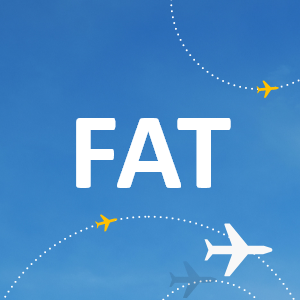

Fresno is in the Central Valley of California, one of the world’s most important and productive agricultural areas. It is the closest city to Yosemite, Sequoia, and Kings Canyon national parks. The metropolitan area anchored by Fresno is the third largest in northern California, after the San Francisco Bay area and the Greater Sacramento region. Fresno Yosemite International Airport (FAT) is the only commercial service airport in the region. The region is a case study because it is a Federal Aviation Administration (FAA)-defined small hub and has shown overall growth in air traffic over the period 2008–2019.

The Region and Its Economy
| 2008 | 2019 | Change # | Change % | |
|---|---|---|---|---|
| Population (000s) | 1,210 | 1,309 | 99 | 8% |
| Total Employment (000s) | 560 | 656 | 96 | 17% |
The Fresno-Madera-Hanford CSA in California’s Central Valley is within the most productive agricultural region in the United States. The region’s population and employment have grown moderately since 2008.
While the area features approximately three times the national average of farm employees, total farm employment in the region declined during the period 2008–2019. However, the recent expansion of food processing, packaging, wholesaling, and agri-food manufacturing has built higher value-added processes on the area’s core agricultural base. The area has seen strong growth in health care employment, as well as growth in hospitality-related employment and administrative and support services. Employment in transportation and warehousing industries has nearly doubled since 2008 as the region positioned itself as a growing logistics and manufacturing center.
Overview of the Airport and Its Air Service

FAT is the primary passenger and commercial service airport for California’s San Joaquin Valley. Due to FAT’s relative geographical isolation, there are no competing commercial service airports within its primary catchment area. There are no other commercial airports within a 3- to 4-hour drive. FAT saw its total (inbound and outbound) passenger numbers increase from 1.2 million passengers in 2008 to nearly 1.9 million in 2019, growing at an annual rate of 4.4 percent.
The number of flights generally declined between 2008 and 2015, in line with broad industry trends of upgauging aircraft and consolidation, but increased afterward. While available seat capacity varied between 2008 and 2015, it then increased by 45 percent.
Connectivity
“Connectivity” generally means the ability to reach a wide range of places in a short amount of time. Connectivity creates efficiencies that make firms more productive, which in turn attracts more businesses that have their choice of locations.
Changes in connectivity at FAT can have notable impacts on how quickly and conveniently Fresno and the Central Valley area can be reached and how local businesses can access outside markets.
Connectivity at FAT in 2019 was 42 percent higher than it was in 2008. While the airport experienced a slight dip in connectivity after 2008, due to a decline in seat capacity, connectivity grew after 2015 when capacity was added to the major hubs at Los Angeles International Airport (LAX), Dallas Fort Worth International Airport (DFW), San Francisco International Airport (SFO), and Denver International Airport (DEN), and service was added to Chicago O’Hare International Airport (ORD).
Air Service and Economic Activity
FAT’s origin and destination (O&D) traffic is highly correlated with the total regional employment. The figure summarizes the relationship between total O&D traffic and regional employment. The correlation coefficient is 0.915. However, correlation does not establish causation. That is, because two matters are correlated does not mean that increases in one causes or leads to increases in the other, or vice versa. It is not evident whether rising total employment levels lead to more air traffic or whether more air traffic leads to more total employment.
Stakeholder Perspectives on the Contributions of Air Service
The interests of the business community and economic development authority in the region are represented by the Fresno County Economic Development Corporation (EDC) and the Fresno Chamber of Commerce. The Fresno EDC is responsible for bringing in new business to the county and works closely with the airport to discuss air service goals (e.g., new markets that would enhance connectivity). The Fresno Chamber works to promote and support the success of the regional business community through effective advocacy, education, and relationship building.
Community stakeholders recognize that regional economic goals are tied to transportation and aviation. They work together to promote solutions to the region’s transportation needs. In April 2021, the community succeeded in convincing Southwest to enter the market, an effort that took 10 to 15 years.
Communicating the Airport’s Economic Impact
According to a 2018 economic impact study, FAT generated an overall economic output of $426 million. The airport uses its economic impact study in its marketing material, in messaging to stakeholders and elected officials at all levels (federal, state, county, and local), and in discussions with federal partners such as the Transportation Security Administration, Customs and Border Protection, FAA, and the Department of Defense.
